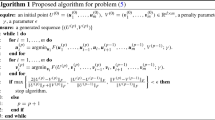Abstract
We formulate the sensor network localization problem as finding the global minimizer of a quartic polynomial. Then sum of squares (SOS) relaxations can be applied to solve it. However, the general SOS relaxations are too expensive to implement for large problems. Exploiting the special features of this polynomial, we propose a new structured SOS relaxation, and discuss its various properties. When distances are given exactly, this SOS relaxation often returns true sensor locations. At each step of interior point methods solving this SOS relaxation, the complexity is \(\mathcal{O}(n^{3})\) , where n is the number of sensors. When the distances have small perturbations, we show that the sensor locations given by this SOS relaxation are accurate within a constant factor of the perturbation error under some technical assumptions. The performance of this SOS relaxation is tested on some randomly generated problems.
Similar content being viewed by others
References
Aspnes, J., Goldberg, D., Yang, Y.R.: On the Computational Complexity of Sensor Network Localization. Lecture Notes in Computer Science, vol. 3121, pp. 32–44. Springer, Berlin (2004)
Benson, S.J., Ye, Y.: DSDP3: Dual scaling algorithm for general positive semidefinite programming. Tech. Report ANL/MCS-P851-1000, Mathematics and Computer Science Division, Argonne National Laboratory (Feb. 2001)
Benson, S.J., Ye, Y.: DSDP5: A software package implementing the dual-scaling algorithm for semidefinite programming. Tech. Report ANL/MCS-TM-255, Mathematics and Computer Science Division, Argonne National Laboratory, Argonne, IL (June 2002)
Benson, S.J., Ye, Y., Zhang, X.: Solving large-scale sparse semidefinite programs for combinatorial optimization. SIAM J. Optim. 10, 443–461 (2000)
Blair, J., Peyton, B.: An introduction to chordal graphs and clique trees. In George, J., Gilbert, J., Liu, J. (eds.) Graph Theory and Sparse Matrix Computations, pp. 1–30. Springer, Berlin (1993)
Blekherman, G.: Volumes of nonnegative polynomials, sums of squares, and powers of linear forms, preprint, arXiv:math.AG/0402158
Blumenthal, L.: Theory and Applications of Distance Geometry. Chelsea Publishing Company, Bronx (1970)
Biswas, P., Ye, Y.: Semidefinite programming for ad hoc wireless sensor network localization. In: Proc. 3rd IPSN, pp. 46–54 (2004)
Biswas, P., Liang, T.C., Toh, K.C., Wang, T.C., Ye, Y.: Semidefinite Programming Approaches for Sensor Network Localization with Noisy Distance Measurements. IEEE Trans. Automat. Sci. Eng. 3(4), 360–371 (2006)
Curto, R.E., Fialkow, L.A.: The truncated complex K-moment problem. Trans. Am. Math. Soc. 352, 2825–2855 (2000)
Doherty, L., Pister, K.S.J., El Ghaoui, L.: Convex Position Estimation in Wireless Sensor Networks. Proc. 20th IEEE Infocom 3, 1655–1663 (2001)
Gatermann, K., Parrilo, P.: Symmetry groups, semidefinite programs, and sums of squares. J. Pure Appl. Algebra 192(1–3), 95–128 (2004)
Henrion, D., Lasserre, J.: GloptiPoly: Global optimization over polynomials with Matlab and SeDuMi. ACM Trans. Math. Soft. 29, 165–194 (2003)
Henrion, D., Lasserre, J.: Detecting global optimality and extracting solutions in GloptiPoly. In: Henrion, D., Garulli, A. (eds.) Positive Polynomials in Control. Lecture Notes on Control and Information Sciences. Springer, Berlin (2005)
Krislock, N., Piccialli, V., Wolkowicz, H.: Robust semidefinite programming approaches for sensor network localization with anchors. CORR 2006-12, May 2006. http://orion.uwaterloo.ca/~hwolkowi/
Kojima, M., Kim, S., Waki, H.: Sparsity in sums of squares of polynomials. Math. Program. 103(1), 45–62
Lasserre, J.: Global optimization with polynomials and the problem of moments. SIAM J. Optim. 11(3), 796–817 (2001)
Man-cho So, A., Ye, Y.: The theory of semidefinite programming for sensor network localization. Math. Program. Ser. B 109, 367–384 (2007)
Moré, J., Wu, Z.: Global continuation for distance geometry problems. SIAM J. Optim. 7, 814–836 (1997)
Nie, J., Demmel, J., Sturmfels, B.: Minimizing polynomials via sum of squares over the gradient ideal. Math. Program. Ser. A 106(3), 587–606 (2006)
Parrilo, P.: Semidefinite Programming relaxations for semialgebraic problems. Math. Program. Ser. B 96(2), 293–320 (2003)
Parrilo, P.: Exploiting structure in sum of squares programs. In: Proceedings for the 42nd IEEE Conference on Decision and Control. Maui, Hawaii (2003)
Parrilo, P., Sturmfels, B.: Minimizing polynomial functions. In: Basu, S., Gonzalez-Vega, L. (eds.) Proceedings of the DIMACS Workshop on Algorithmic and Quantitative Aspects of Real Algebraic Geometry in Mathematics and Computer Science, March 2001, pp. 83–100. American Mathematical Society, Providence (2003)
Prajna, S., Papachristodoulou, A., Parrilo, P.: SOSTOOLS User’s Guide. Website: http://www.mit.edu/~parrilo/SOSTOOLS/
Reznick, B.: Extremal psd forms with few terms. Duke Math. J. 45, 363–374 (1978)
Saxe, J.: Embeddability of weighted graphs in k-space is strongly NP-hard. In: Proc. 17th Allerton Conference in Communications, Control, and Computing, Monticello, IL, pp. 480–489 (1979)
Sturm, J.F.: SeDuMi 1.02, a MATLAB toolbox for optimization over symmetric cones. Optim. Methods Soft. 11&12, 625–653 (1999)
Sturmfels, B.: Solving systems of polynomial equations. Am. Math. Soc., CBMS regional conferences series, No. 97, Providence, Rhode Island, 2002
Tseng, P.: Second-order cone programming relaxation of sensor network localization. SIAM J. Optim. 18(1) 156–185 (2007)
Waki, H., Kim, S., Kojima, M., Muramatsu, M.: Sums of squares and semidefinite programming relaxations for polynomial optimization problems with structured sparsity. SIAM J. Optim. 17(1), 218–242 (2006)
Waki, H., Kim, S., Kojima, M., Muramatsu, M.: SparsePOP: a sparse semidefinite programming relaxation of polynomial optimization problems. http://www.is.titech.ac.jp/~kojima
Wolkowicz, H., Saigal, R., Vandenberghe, L. (eds.): Handbook of Semidefinite Programming. Kluwer Academic, Dordrecht (2000)
Author information
Authors and Affiliations
Corresponding author
Rights and permissions
About this article
Cite this article
Nie, J. Sum of squares method for sensor network localization. Comput Optim Appl 43, 151–179 (2009). https://doi.org/10.1007/s10589-007-9131-z
Received:
Revised:
Published:
Issue Date:
DOI: https://doi.org/10.1007/s10589-007-9131-z




